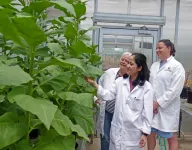(Press-News.org) DURHAM, N.C. -- Humans aren't the only mammals that form long-term bonds with a single, special mate -- some bats, wolves, beavers, foxes and other animals do, too. But new research suggests the brain circuitry that makes love last in some species may not be the same in others.
The study, appearing Feb. 12 in the journal Scientific Reports, compares monogamous and promiscuous species within a closely related group of lemurs, distant primate cousins of humans from the island Madagascar.
Red-bellied lemurs and mongoose lemurs are among the few species in the lemur family tree in which male-female partners stick together year after year, working together to raise their young and defend their territory.
Once bonded, pairs spend much of their waking hours grooming each other or huddled side by side, often with their tails wrapped around each other's bodies. Males and females of these species spend a third of a lifetime with the same mate. The same cannot be said of their closest relatives, who change partners often.
To biologists, monogamy is somewhat a mystery. That's in part because in many animal groups it's rare. While around 90% of bird species practice some form of fidelity to one partner, only 3% to 5% of mammals do. The vast majority of the roughly 6,500 known species of mammals have open relationships, so to speak.
"It's an uncommon arrangement," said lead author Nicholas Grebe, a postdoctoral associate in professor Christine Drea's lab at Duke University.
Which raises a question: what makes some species biologically inclined to pair up for the long haul while others play the field?
Studies over the last 30 years in rodents point to two hormones released during mating, oxytocin and vasopressin, suggesting that the key to lasting love may lie in differences in how they act on the brain.
Some of the first clues came from influential research on prairie voles, small mouse-like mammals that, unlike most rodents, mate for life. When researchers compared the brains of monogamous prairie voles with their promiscuous counterparts, montane voles and meadow voles, they found that prairie voles had more "docking sites" for these hormones, particularly in parts of the brain's reward system.
Since these "cuddle chemicals" were found to enhance male-female bonds in voles, researchers have long wondered if they might work the same way in humans.
That's why the Duke-led team turned to lemurs. Despite being our most distant primate relatives, lemurs are a closer genetic match to humans than voles are.
The researchers used an imaging technique called autoradiography to map binding sites for oxytocin and vasopressin in the brains of 12 lemurs that had died of natural causes at the Duke Lemur Center.
The animals represented seven species: monogamous red-bellied and mongoose lemurs along with five promiscuous species in the same genus.
"They're really the only comparable natural experiment to look for biological signatures of monogamy in primates," Grebe said.
Comparing the brain imaging results in lemurs with previous results in voles and monkeys revealed some noticeable differences in the density and distribution of hormone receptors. In other words, oxytocin and vasopressin appear to act on different parts of the brain in lemurs -- which means they may also have different effects, depending on their target cell's location.
But within lemurs, the researchers were surprised to find few consistent differences between monogamous species and promiscuous ones.
"We don't see evidence of a pair-bond circuit" akin to that found in rodent brains, Grebe said.
As a next step, the team is looking at how lemur couples behave toward each other if the actions of oxytocin are blocked, by feeding them an antagonist that temporarily prevents oxytocin from binding to its receptors in the brain.
So what can lemurs teach us about love? The authors say their findings caution against drawing simple conclusions based on rodent experiments about how human social behaviors came to be.
Oxytocin may be the "potion of devotion" for voles, but it may be the combined actions and interactions of multiple brain chemicals, along with ecological factors, that create long-lasting bonds in lemurs and other primates, including humans, Grebe said.
"There are probably a number of different ways through which monogamy is instantiated within the brain, and it depends on what animals we're looking at," Grebe said. "There's more going on than we originally thought."
INFORMATION:
Other authors were: Annika Sharma at Duke, Sara Freeman at Utah State University, Michelle Palumbo at the California National Primate Research Center, Heather Patisaul at North Carolina State University, and Karen Bales at the University of California, Davis.
This work was supported by grants from the National Science Foundation (SBE-1808803), the National Institute of Mental Health (NIMH R21MH115680), the Josiah Charles Trent Memorial Foundation Endowment Fund, the Charles Lafitte Foundation for Research, and Duke University.
CITATION: "Neural Correlates of Mating System Diversity: Oxytocin and Vasopressin Receptor Distributions in Monogamous and Non-Monogamous Eulemur," Nicholas Grebe, Annika Sharma, Sara Freeman, Michelle Palumbo, Heather Patisaul, Karen Bales, and Christine Drea. Scientific Reports, Feb. 12, 2021. DOI: 10.1038/s41598-021-83342-6
Every year around 20 Australian children die from the incurable brain tumour, Diffuse Intrinsic Pontine Glioma (DIPG). The average age of diagnosis for DIPG is just seven years. There are no effective treatments, and almost all children die from the disease, usually within one year of diagnosis.
A paper published today 12 Feb 2021 in the prestigious journal, Nature Communications, reveals a potential revolutionary drug combination that - in animal studies and in world first 3D models of the tumour - is "spectacularly effective in eradicating the cancer cells," according to lead researcher and paediatric oncologist Associate Professor David Ziegler, from the Children's Cancer Institute and Sydney Children's Hospital.
In ...
Children treated for cancer with approaches such as chemotherapy can develop therapy-related myeloid neoplasms (a second type of cancer) with a dismal prognosis. Scientists at St. Jude Children's Research Hospital have characterized the genomic abnormalities of 84 such myeloid neoplasms, with potential implications for early interventions to stop the disease. A paper detailing the work was published today in Nature Communications.
The somatic (cancer) and germline (inherited) genomic alterations that drive therapy-related myeloid neoplasms in children have not been comprehensively ...
(Friday, February 12, 2021 - Toronto) -- Inhibiting a key enzyme that controls a large network of proteins important in cell division and growth paves the way for a new class of drugs that could stop glioblastoma, a deadly brain cancer, from growing.
Researchers at Princess Margaret Cancer Centre, the Hospital for Sick Children (SickKids) and University of Toronto, showed that chemically inhibiting the enzyme PRMT5 can suppress the growth of glioblastoma cells.
The inhibition of PRMT5 led to cell senescence, similar to what happens to cells during aging when cells lose the ability to divide and grow. Cellular senescence can also be a powerful tumour suppression mechanism, stopping ...
Space: the final frontier. What's stopping us from exploring it? Well, lots of things, but one of the major issues is space radiation, and the effects it can have on astronaut health during long voyages. A new review in the open-access journal END ...
Research over the last 20 years has shown that atherosclerosis is a chronic inflammatory condition of the arterial blood vessel wall. Soluble mediators such as cytokines and chemokines are pivotal players in this disease, promoting vascular inflammation. However, the development of anti-inflammatory therapeutics directed against such mediators that could prevent atherosclerosis has proven difficult, despite promising clinical studies in the recent past.
Previous anti-inflammatory therapeutic strategies to prevent atherosclerosis, heart attacks, strokes, rheumatoid arthritis and other inflammatory diseases have mainly been based ...
Remote sensing technology has become a vital tool for scientists over the past several decades for monitoring changes in land use, ice cover, and vegetation across the globe. Satellite imagery, however, is typically available at only coarse resolutions, allowing only for the analysis of broad trends over large areas. Remote-controlled drones are an increasingly affordable alternative for researchers working at finer scales in ecology and agriculture, but the laser-based technology used to estimate plant productivity and biomass, such as light detection and ranging (LiDAR), remain prohibitively expensive.
In research presented in a recently published issue of Applications in Plant Sciences, researchers ...
New research has shown that results of blood tests routinely performed by GPs everywhere contain a hidden fingerprint that can identify people silently developing potentially fatal liver cirrhosis.
The researchers have developed an algorithm to detect this fingerprint that could be freely installed on any clinical computer, making this a low-cost way for GPs to carry out large scale screening using patient data they already hold.
Liver cirrhosis is the second leading disease causing premature death in working-age people (after heart disease). It develops silently ...
Peer-reviewed / Observational study / People
For the study, published in the journal Diabetes, Obesity and Metabolism, researchers analysed data from the UK Biobank of 500,000 people aged 58 years on average, and found that people with higher than normal blood sugar levels were 42% more likely to experience cognitive decline over an average of four years, and were 54% more likely to develop vascular dementia over an average of eight years (although absolute rates of both cognitive decline and dementia were low).
The associations remained true after other influential factors had been taken into account - including age, deprivation, smoking, BMI and whether or not participants had cardiovascular disease.
People with ...
A team of scientists have measured the relative importance of the different obstacles that carbon dioxide (CO2) encounters in its voyage from the atmosphere to the interior of plant cells, where it is converted into sugars. This research leading method provides much needed information that will help to increase the yield of important food crops such as cowpea, soybean and cassava.
"Our data highlights promising targets to improve the diffusion of CO2 through the leaf with the aim of boosting crop productivity," says lead author Dr Tory Clarke, who works at The Australian National University (ANU), as part of the Realizing Increased Photosynthetic ...
Psychologists at the University of Bath, Cardiff, and London have developed the first ever 'mind-reading questionnaire' to assess how well people understand what others are really thinking.
A new approach to 'mind-reading' has been developed by researchers at the University of Bath, Cardiff, and London to improve how well we understand what others are thinking. And it transpires that women are much better than men at putting themselves in someone else's shoes.
Mind-reading, sometimes referred to in psychology as 'mentalising', is an important ability enabling us to pick-up on subtle behavioural cues that might indicate that someone we are speaking to is thinking ...




